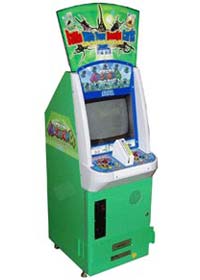Overview
 An arcade cabinet of Mushiking, an early example of a simple TCAG. Note the card scanner in the center of the panel and the dispenser at the bottom.
An arcade cabinet of Mushiking, an early example of a simple TCAG. Note the card scanner in the center of the panel and the dispenser at the bottom.Trading Card Arcade Games, sometimes known as TCAG, are arcade games that use real-life collectible cards, which are dispensed by the machine themselves and scanned on the machine's control panel (usually with barcode or QR-code scanning, rarely with NFC). These should not be confused for IC Card systems that track player progress or games with digital card collections. The concept is similar to toys-to-life console games.
These types of games are more common in Japan, and are more commonly used in arcade games made for children and teenagers since the mid-2000's. The first known game to use this concept was World Club Champion Football Serie A 2002-2003, and the first children's arcade game to use it was Mushiking: The King of Beetles. One of the most common series is Bandai's Data Carddass, which ties in with various licensed properties (such as Dragon Ball and Kamen Rider).
Some games of this type, such as the ones for Pokémon, do not use standard trading cards, instead using uniquely-shaped tokens (such as discs, squares, or tags). These usually have an associated toy scanner sold separately, similar to barcode-based toy games, for both checking stats and making simple battles. Some games, such as Disney Tsum Tsum, use toy figurines instead of cards.
Card Usage
The cards themselves are not used like a traditional collectible card game, instead being used in one of two ways:
Some card-based games made after the mid-2010's use on-demand card printing, which allow the game to include upgradable cards with higher stats and different abilities.
Card Dispensal & Collection
All games of this type have the same method for dispensing cards: one card at the beginning or end of each credit, regardless of the credit's result or player's performance. In Japan, this is to prevent the games from being considered, and regulated as, "prize games", with those for children often being considered "card vending machines" for use in department stores and supermarkets (rather than game centers). Some games, particularly ones made starting in the 2010's, allow players to use their credit to simply purchase cards on-demand (or use multiple credits for multiple card purchases) in order to prevent some troublesome collectors from abusing quick gameplay to earn many cards in a short time (at the hinderance of those waiting to actually play the game, and those expecting a fair fight in player-vs-player matches).
Like booster packs of most real-life collectible card games (as well as loot boxes and gacha games in general), most of these games have a random blind draw of the card they earn, which may come in one of multiple rarities. While rarer cards normally don't come with any gameplay advantage, they can trade at a higher market to card collectors and can show some prestige in multiplayer games. This has caused some issues with operators either removing the rare cards from card refill shipments (re-selling it for a profit while making it difficult-to-impossible for normal players to win those cards) or selling card refill shipments outright (which is against the manufacturer's contract).
Some games made after the mid-2010's use card and photo printers that print trading cards on-demand instead of a issuing a random blind draw from a pile of cards. This allows games to print more customizable cards, with some games allowing upgradable cards and some games allowing players to choose which card from a random set (usually the CPU opponents they face) to print. As operators now deal with blank stock rather than pre-determined card shipments, this eliminates operator meddling with the machine's card stock while allowing updates of the game to introduce new cards without needing a shipment and allowing games to still dispense cards long after its official discontinuation.
Game & Card Discontinuation
When a normal card-based arcade game is discontinued from the manufacturer, the operators receive no more card refills, forcing them to either rely on the second-hand market or disallow any more card dispensing (making them less fun, sometimes impossible, for players without cards).
In Japan, children's-style arcade games that no longer dispense cards are no longer considered "card vending machines" and cannot legally be used in general stores as standard arcade machines. As these types of TCAG are generally not used in game centers and are often rented from the manufacturer, this makes their survivability rare.
As games with on-demand card printers only require a blank stock, which may be re-used for multiple games, the above issues are less of a concern for them.
In addition, manufacturers have been reluctant to allow players to use discontinued trading cards for home use, either through toy/smartphone scanners or as a traditional collectible card game. Very few games allow this, such as the Pokémon Tretta Lab for Nintendo 3DS peripheral.
Log in to comment